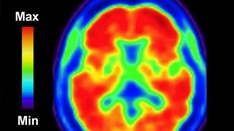Background
Delirium, dementia, amnesia (and certain other alterations in cognition, judgment, and/or memory) are grouped together in this article as organically based disruptions of brain functioning. While psychiatric illnesses can at times mimic some features of these conditions or complicate their presentation in the emergency department, the primary etiologies are physiological rather than psychiatric. Causes of these conditions include metabolic disruptions, endocrine dysfunction, drug toxicity, structural injury (eg, trauma, stroke, chronic dementing process), brain ischemia, severe physiologic/psychological stressors (including prolonged sensory deprivation, "ICU psychosis", sleep deprivation), encephalitis and sepsis.
Pathophysiology
Altered mental status can be divided into 2 major subgroups: acute (delirium or acute confusional state) and chronic (dementia). A third entity, encephalopathy (subacute organically based brain dysfunction), denotes a gray zone between these extremes; its early course may fluctuate and/or resolve, but it is often persistent and progressive.
The final common pathway of all forms of organically based mental status change is an alteration in cortical brain function, at times in concert with abnormalities of deep brain structures. These conditions result from (1) an exogenous insult or an intrinsic process that affects cerebral neurochemical functioning and/or (2) physical or structural damage to the cortex, subcortex, or to deeper structures involved with memory. Some of the etiologies include trauma, mass lesions, hydrocephalus, strokes (ie, multi-infarct dementia), atrophy, infection, toxins, or dementing processes.
The end result of these disruptions of brain function and/or structure is impairment of cognition that affects some or all of the following: alertness, orientation, emotion, behavior, memory, perception, language, praxis, problem solving, judgment, and psychomotor activity. Knowledge of which areas of this spectrum are affected or spared guides both the workup and the diagnosis.
Epidemiology
Frequency
Delirium accounts for or develops during 10–15% of all admissions to acute-care hospitals but is seen much more frequently in elderly persons (up to 75% of seriously ill and hospitalized), particularly following major surgery, trauma or prolonged ICU care. ICU delirium, with a prevalence estimated at 31.8%, is associated with increased ICU length of stay, longer mechanical ventilation duration, and increased mortality. [1] Delirium is usually transient, but it can be persistent leading to a chronically dementing process in elderly patients.
The prevalence of dementia doubles every 5 years between ages 60 to about 90 years: 1% of persons aged 60–64 years up to 30–50% of those older than 85 years. Approximately 60% of nursing home beds are occupied by patients with dementia. In the ED, patients in nursing homes are more likely to present with delirium than other patients, even after adjusting for delirium risk factors. [2] Alzheimer disease (AD) accounts for most patients with dementia who are older than 55 years (50–90% of all cases). It is estimated that over 4 million people in the United States suffer from AD.
Although slowing of memory and word-finding are normal features of brain aging, approximately 10–15% of patients with mild cognitive impairment, a transitional state between normal functioning and dementia, progress to AD yearly.
For as yet unknown reasons, dementia rates in the United States have been declining over the past several years.
Alzheimer disease is less common and has an older age of onset in Japan, China, and parts of Scandinavia. In these countries, vascular causes of dementia may outnumber Alzheimer disease.
Mortality/Morbidity
Some causes of delirium (eg, delirium tremens, severe hypoglycemia, CNS infection, heatstroke, thyroid storm) may be fatal or result in severe morbidity if unrecognized and untreated. With some exceptions (such as overdose with tricyclic antidepressants), drug intoxications generally resolve fully with supportive care alone. Failure to provide thiamine when administering glucose may rarely lead to acute Wernicke syndrome (ataxia, confusion, oculomotor palsies in the setting of malnutrition). If unrecognized, Wernicke syndrome may also result in chronic dementia.
Certain withdrawal syndromes can present with delirium (eg, alcohol, benzodiazepines, barbiturates and naloxone-induced acute opiate withdrawal). Some of these withdrawal states can be fatal if if not aggressively treated.
Patients with primary dementia have a significantly reduced life expectancy, depending on the cause of the dementia and its severity and rapidity of progression. [3]
Race
There is no specific data collected to detect specific rates of delirium between races in the Emergency Department. In the United States, dementia is more prevalent in African American, American Indian/Alaska Native, intermediate in Latinos, Pacific Islanders and Whites, and lowest among Asian Americans. [4]
Sex
Delirium is seen more commonly in males, [5] while Alzheimer disease and dementia is more prevalent among women because of their longer life expectancy. Lifetime risk in women is estimated to be 32%, whereas the lifetime risk in men is 18%. However, the age-specific risk is equal in both sexes.
Age
Delirium due to physical illness is more frequent among the very young and those in advanced age. Delirium due to drug and alcohol intoxication or withdrawal is most frequent in persons aged mid-teens to late thirties.
Dementia, particularly Alzheimer disease, is seen predominantly in elderly persons; however, certain types of dementia are seen in younger patients (eg, AIDS-related dementia, certain familial forms of Alzheimer disease), and some cases of variant Creutzfeldt-Jakob disease (ie, bovine spongiform encephalopathy or mad cow disease).
Lifestyle
Smoking, obstructive sleep apnea, alcohol excess, atrial fibrillation, renal dysfunction, obesity, and heart failure have been reported as risk factors for developing delirium. [6] Of all causes of dementia, these are the most modifiable in order to reduce dementia risk.
Genetic Factors
Early-onset familial Alzheimer's disease, a rare subtype occurring in patients 30–60 years of age, is typically caused by an inherited mutation in one of three genes: chromosomes 21, 14 and 1. Transmission is autosomal dominant with a high degree of penetration. Other types of early-onset dementia have no known specific causes. Typical late-onset AD, first manifesting around the mid-sixties and older, may have some genetically inheritable risk, particularly involving the apolipoprotein E gene on chromosome 19. Researchers have now identified many other areas of interest in the Alzheimer's genome that may prove to increase risk of developing the disease to varying degrees. [7]
Prognosis
One prospective cohort study of acutely ill hospitalized older adults observed that delirium occurred in 47% of admissions. One in three of these admissions resulted in death during hospitalization, with a cumulative mortality of 52% in 12 months. Although hypoactive delirium is usually described as potentially more severe than other forms, results presented in the literature on prognostic differences among the subtypes of delirium are sparse and conflicting. [8]
Delirium is fully reversible in most cases with proper recognition and treatment of the etiology. However, some cases of delirium can last weeks or months and can become chronic.
Dementia is usually insidious and relentlessly progressive. However, about 20–30% of cases are due to reversible causes. On average, patients with Alzheimer disease die within 8 years of onset, with a range of 2–15 years. Younger patients usually have a more fulminant course. Pick disease has a similar course.
Subacute encephalopathy may be reversible, persistent, or progressive.
-
Coronal T1-weighted MRI scan in a patient with moderate Alzheimer disease. Brain image reveals hippocampal atrophy, especially on the right side.









